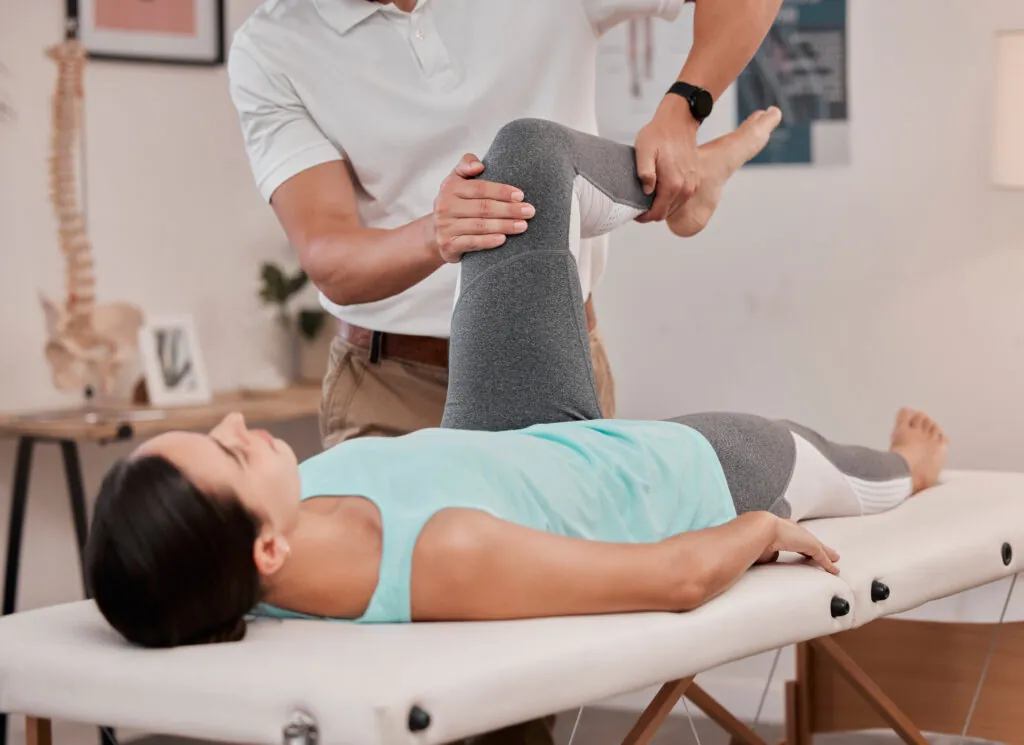[tsf_breadcrumb sep="/" class="breadcrumbs]
Home / Patients / Primary Services / Post-Surgical Rehabilitation
After surgery, the road to recovery can feel long, but you don’t have to walk it alone. We work with you to rebuild strength, improve mobility, and return to your normal routine as quickly as possible. Each rehabilitation plan is tailored to your specific surgery and goals, ensuring that your recovery is smooth and effective. Together, we’ll focus on restoring your body’s full function and helping you get back to the things you enjoy.
Post-surgical rehabilitation refers to the process of recovery that restores and improves a patient’s physical function after surgery. Physical therapy can play a large part in this type of rehabilitation by helping patients manage pain levels, increase mobility, and successfully return to pre-operative activities. Post-surgical rehabilitation may also include other interventions, like wound care, nutritional support, and psychological counseling.
Physical therapy can begin as soon as a few hours after surgery to reduce the risk of complications and improve overall quality of life. For example, research has shown that early mobilization of the post-operative hip and lower extremity can have several benefits, including reduced pain levels, improved walking ability, and increased overall patient satisfaction.1
Physical therapy can also help address the temporary mobility and strength limitations often present post-operatively. Physical therapists aim to reduce these limitations with exercises, hands-on techniques, patient education, and modalities like heat and ice. As your healing progresses, your physical therapist will advance your treatment to ensure your rehabilitation is optimized to achieve your post-operative goals.
Surgery can also result in increased pain levels as the body heals post-operatively. Your physical therapist will work with you to ensure your comfort during your sessions. This will help maximize your engagement with your treatment plan, improving overall outcomes.
Physical therapy is an essential component of post-surgical rehabilitation. If you have undergone surgery or are planning to undergo surgery, call Confluent Health today to schedule an appointment with an experienced physical therapist to discuss your post-surgical rehabilitation. With Direct Access, you do not need a physician referral to be seen.
After surgery, you may experience some common post-operative issues and conditions:
Post-surgical physical therapy can help manage these issues as they arise. Your physical therapist will regularly assess you for these issues; however, it’s important to communicate with them if you are experiencing any of the above.
The severity and specifics of these issues will vary depending on the surgical procedure performed. Your physical therapist will perform a thorough evaluation before creating an individualized treatment plan tailored to your needs and goals.

Early physical therapy intervention after surgery can reduce the risk of post-operative complications.2 Therefore, physical therapy is often administered during a patient’s post-surgical hospital stay or at a hospital-affiliated post-surgical rehab center. While this is an important step in the process, rehab after surgery does not end when you are discharged from the hospital. Strength and mobility limitations can persist for months after the surgical procedure, making outpatient physical therapy the essential link between your post-surgical status and returning to the activities you love.
If you’ve had surgery or are planning to have surgery, call Confluent Health to schedule an appointment with one of our experienced physical therapists. With Direct Access, you don’t need a referral to see a physical therapist.
At your first post-surgical physical therapy appointment, your physical therapist will perform an in-depth initial evaluation. They will begin by reviewing your medical history and any post-surgical instructions from your surgeon before moving on to a physical examination.
During the physical examination, they will assess your posture, range of motion, strength, tissue tenderness, balance, and gait (walking) to determine your current physical status. They will also assess your surgical incision to check for signs of infection and proper healing. The level of physical testing may vary based on the surgical procedure performed.
You may also be asked to perform some functional tasks, like squatting or reaching, if appropriate. Your physical therapist will observe and note any areas of weakness or instability. The specifics of the evaluation will depend on the type of surgical procedure performed.
The initial evaluation is an excellent time to discuss any concerns with your physical therapist. If you forget, you can always talk to your physical therapist at any of your subsequent treatment sessions. Open communication between you and your physical therapist is necessary for a successful plan of care. The partnership between the patient and their physical therapist is called a therapeutic alliance. When there is a strong therapeutic alliance, this can have a positive effect on functional outcomes.3 Your physical therapist will encourage active participation in your treatment sessions and work with you to achieve your post-surgical goals.
Dealing with post-surgical pain can be difficult. Talk to your physical therapist about ways to manage your pain at home. In addition to encouraging your active participation in your physical therapy treatment plan, they may recommend additional rest, heat or ice, and supportive bracing or taping. Your physical therapist may also recommend activity modification to help you continue participating in your activities while minimizing pain and discomfort.
Your physical therapist can also guide you through other coping techniques to manage your post-surgery pain. This may include:
Despite best efforts, sometimes flare-ups happen. If you are experiencing a post-surgical pain flare-up, focus on rest, stress management, and gentle movement. Contact your physical therapist as soon as you can to discuss your flare-up symptoms and strategies to manage the pain.
Everyone’s post-surgical rehabilitation will be different, and your physical therapist will take that into account as they create your personalized treatment plan. They will work with you to design a plan of care tailored to your needs and goals. As you progress, your physical therapist will regularly reassess your physical and functional status to ensure your treatment plan optimizes your rehab.
Post-surgical rehabilitation can be daunting, especially when you are in pain. Call Confluent Health to schedule an appointment with an experienced physical therapist who can guide you through recovery and get you back to doing what you love. With Direct Access, you don’t need a physician referral to be seen by a physical therapist.

Post-surgical rehabilitation is the entire process of recovery after a surgical procedure. It includes many different interventions like physical therapy, occupational therapy, nutritional guidance, and psychological counseling. These interventions are focused on effectively managing post-surgical pain through pharmacologic (medications, nerve blocks) and non-pharmacologic (physical therapy) means.
Physical therapy can address post-surgical pain using exercises, hands-on techniques, patient education and modalities like heat and ice. Early in rehabilitation, gentle exercises and mobilization are introduced to get the targeted areas moving to promote circulation and reduce joint stiffness. As healing progresses, your exercises will progress as well to address areas of limited range of motion and strength.
Your physical therapist will also introduce functional exercises. These are exercises that are specifically designed to help you get back to daily activities like climbing stairs and walking. Your physical therapist will introduce these exercises at the appropriate time during your plan of care.
Physical therapists may also use modalities to manage post-surgical pain. In addition to topical heat and ice application, your physical therapist may use transcutaneous electrical nerve stimulation (TENS) to reduce pain levels. Your physical therapist will discuss possible modalities for pain management at the appropriate time during your care.
Your physical therapist will use information collected at your initial evaluation to make these care decisions. The initial evaluation is conducted during your first physical therapy appointment and includes a medical history and post-surgical instruction review, physical examination and functional assessment. Using this information, your physical therapist will create a personalized treatment plan for each patient, ensuring your treatments align with your therapy goals.
You will work with your physical therapist to determine your therapy goals. This could include things like navigating the stairs inside your house, or walking to the mailbox at the end of your driveway. Some patients will have goals to return to their occupation, or their favorite recreational activity. Talk with your therapist about what activities are important to you—this will result in an individualized plan of care tailored to meeting your goals.
Depending on your surgical procedure, you may have to limit or avoid certain activities immediately after surgery before gradually reintroducing them as your body heals. Your physical therapist is an expert at progressing patients through their treatment plans based on qualitative and quantitative milestones. For example, if a post-surgical protocol states that a patient may begin running 3–4 months after their procedure, your physical therapist will ensure that you meet the pre-requisite requirements of leg strength and control before attempting running.
This illustrates one of the most important aspects of post-surgical physical therapy—safely progressing through rehabilitation. Your physical therapist is an expert at balancing time-based protocols with qualitative milestones to optimize healing and recovery. Their aim is to help you achieve your personalized post-surgical therapy goals as efficiently and safely as possible.
Post-surgical pain can be debilitating, affecting every aspect of your daily life. Your physical therapist can help you effectively manage your post-surgical pain. Take proactive steps towards seeking relief by calling Confluent Health today to schedule an appointment with an experienced physical therapist. With Direct Access, you don’t need a physician referral to be seen.
The primary goals are to restore function, decrease pain, and promote healing while preventing complications.
This depends on the type of surgery, but PT often starts within a few days post-operation to optimize recovery.
PT is important for regaining range of motion, strength, and functionality in joints after replacement surgery.
You should start physical therapy as soon as you can after surgery. Talk to your physical therapist about when to start therapy following your procedure. They can tell you the right time to begin your post-surgical physical therapy treatments.
Lengths will vary depending on the procedure performed. However, post-surgical mobility and strength issues can persist for months, limiting participation in your favorite activities. Physical therapy treatment plans can extend for several months, but the frequency of visits may decrease as your healing progresses.
Your physical therapist will ensure you are as comfortable as possible during your treatment sessions to encourage full participation. Talk to your physical therapist about any pain concerns you may have when starting therapy.
You will notice improved mobility and strength as you progress through your treatments. Your physical therapist will perform regular reassessments to track your progress.